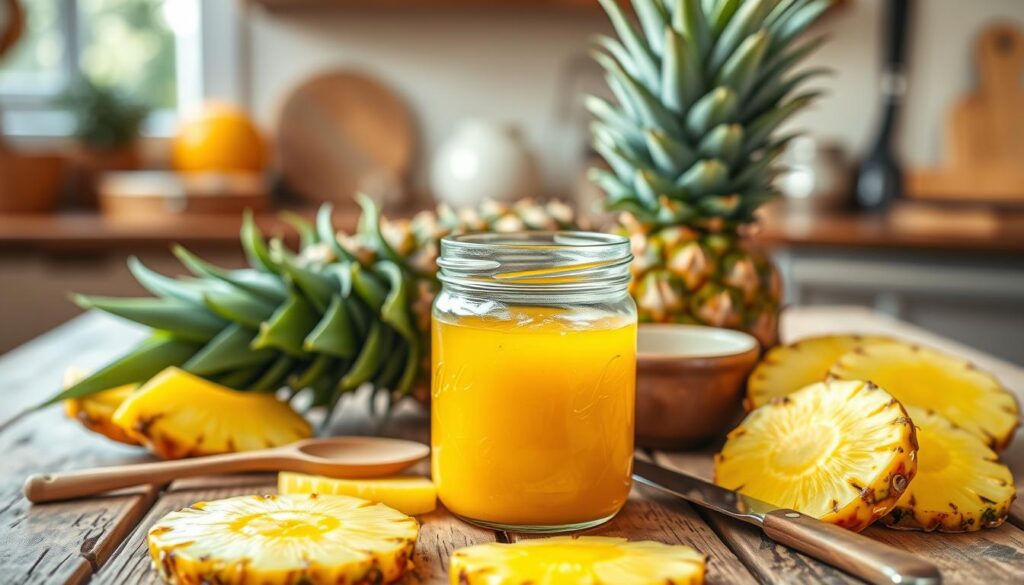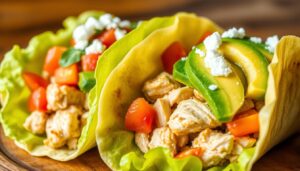Growing up in my family’s kitchen, tropical fruit jam was more than just a spread—it was a cherished tradition. My grandmother’s vibrant yellow pineapple jam always made ordinary toast feel like a burst of sunshine.
Pineapple is the fourth-largest tropical fruit worldwide. It offers more than just delightful flavor. A homemade pineapple jam recipe can unlock incredible nutritional benefits while satisfying your sweet tooth with natural goodness.
Why choose homemade tropical fruit jam? Commercial jams often hide excessive added sugars. But making your own pineapple jam lets you control ingredients and maximize health advantages. From boosting vitamin C intake to enjoying pure, natural sweetness, this journey into pineapple jam is about reclaiming your nutritional power.
In the following sections, we’ll explore the science behind pineapple’s remarkable nutritional profile. We’ll uncover the secrets of creating the perfect pineapple jam recipe. And we’ll reveal why this tropical delight deserves a spot in your healthy diet.
Understanding Pineapple’s Nutritional Profile
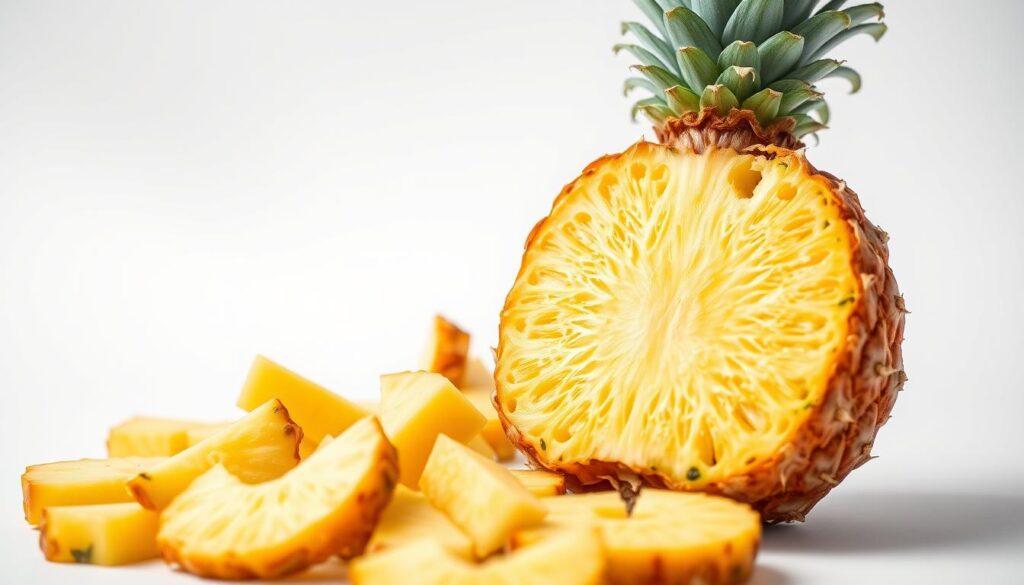
Pineapples are full of health benefits. They are packed with nutrients that can improve your well-being. Enjoying homemade jam made with pineapples is a treat for your body.
Key Vitamins and Minerals
Pineapple preserves are good for you. They have vitamins and minerals that your body needs:
- Vitamin C: Supports immune system health
- Manganese: Promotes bone strength
- Vitamin B6: Helps metabolism
- Potassium: Supports heart function
Antioxidant Powerhouse
Pineapples are full of antioxidant compounds. These compounds protect your cells from harm. The main antioxidants are:
| Antioxidant | Potential Benefits |
|---|---|
| Flavonoids | Reduce inflammation |
| Phenolic Acids | Combat free radical damage |
| Bromelain | Supports digestive health |
Natural Sugar Content
Homemade jam made with pineapples is sweet but not too sugary. A fresh pineapple has about 10 grams of sugar per 100 grams. This makes it a good choice for your jam.
The Science Behind Pineapple Jam Making
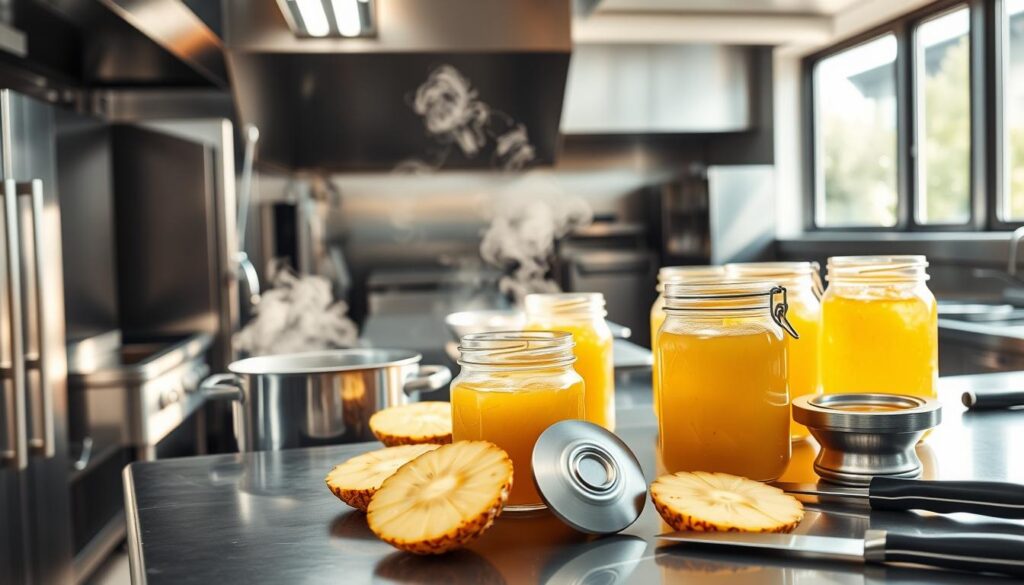
Making pineapple jam is a cool science experiment. It turns fresh fruit into a tasty treat. When you start canning, knowing how fruit changes is key to making great jam.
The magic of jam-making comes from three main science rules:
- Pectin activation through heat treatment
- Sugar concentration for preservation
- Acid balance for gel formation
Pectin is super important in making jam. It’s a natural part of fruit that makes jam thick and smooth. When you heat pineapple, pectin changes, making your jam spreadable and yummy.
Keeping the temperature right is crucial. Heating pineapple to the perfect temperature does a few things:
- Kills off bad bacteria
- Makes sugars more concentrated
- Brings out the flavors
Sugar does more than just sweeten your jam. It also helps keep it fresh by reducing moisture and stopping bacteria. The right mix of sugar and fruit decides how long your jam lasts and how it feels.
Successful jam-making is a delicate balance of science and culinary art.
By grasping these science basics, you can make pineapple jam that’s not just tasty but also lasts for months.
Health Benefits of Homemade Pineapple Jam
Making homemade pineapple jam is more than just a tasty treat. It’s a way to boost your health and wellness. This sweet spread is packed with nutrients.
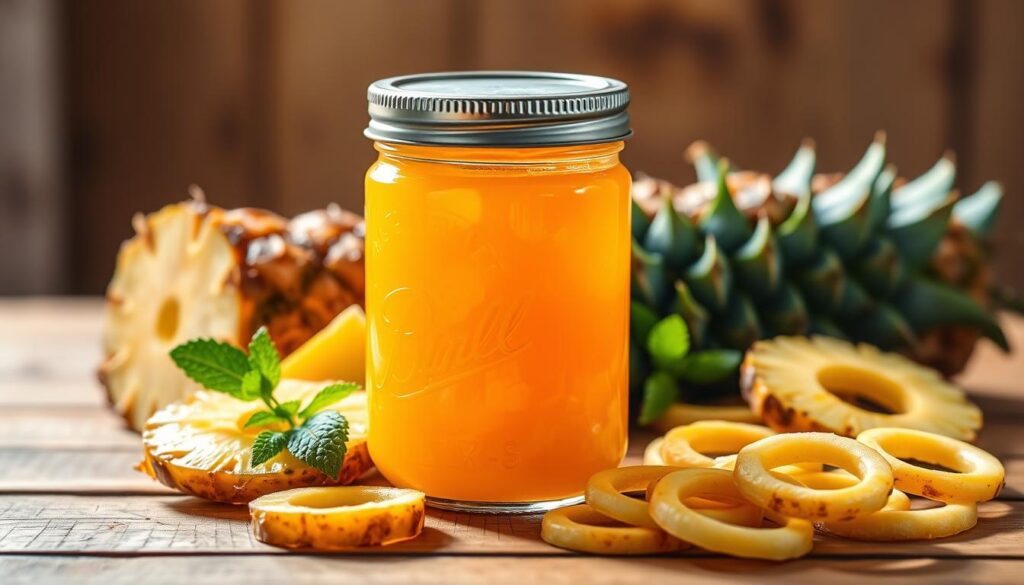
Pineapple jam is not just yummy. It’s also full of nutrients that support your body. Let’s look at the amazing health benefits it offers.
Digestive Enzyme Benefits
Bromelain, a special enzyme in pineapples, is great for digestion. It helps break down proteins, which can improve digestion and reduce bloating. Making homemade pineapple jam keeps these enzymes in your food, helping your gut.
- Assists protein digestion
- Reduces digestive discomfort
- Supports enzyme activity in the gut
Immune System Support
Your homemade pineapple dessert can boost your immune system. It’s full of vitamin C, which strengthens your body’s defenses. Eating it regularly might help you fight off illnesses faster.
Anti-Inflammatory Properties
Pineapple’s natural compounds have strong anti-inflammatory effects. Bromelain has been studied for its ability to reduce body inflammation. This makes your jam not only tasty but also potentially healing.
| Health Benefit | Key Compounds | Potential Impact |
|---|---|---|
| Digestive Support | Bromelain | Protein digestion improvement |
| Immune Boost | Vitamin C | Enhanced immune response |
| Anti-Inflammation | Bromelain, Antioxidants | Reduced inflammatory markers |
Choosing homemade pineapple jam is more than just making a tasty spread. It’s creating a nutritious food that helps your body heal and stay healthy.
Vitamin C Content in Pineapple Jam
Exploring kitchen skills for making pineapple jam is key. It’s important to know its vitamin C content. Pineapple is a top source of this nutrient, offering great health benefits.
A single cup of fresh pineapple has about 78.9 milligrams of vitamin C. This is 88% of what you need daily. Even though some vitamin C is lost when making jam, a lot of its nutritional value stays.
- Vitamin C supports immune system function
- Helps in collagen production
- Acts as a powerful antioxidant
To keep more vitamin C in your jam, try these tips:
- Minimize cooking time
- Use low-heat methods
- Add fresh pineapple chunks after initial cooking
| Pineapple Form | Vitamin C Content | Nutrient Retention |
|---|---|---|
| Fresh Pineapple | 78.9 mg per cup | 100% |
| Homemade Pineapple Jam | 55-65 mg per cup | 70-85% |
| Store-Bought Jam | 30-45 mg per cup | 40-60% |
Pro tip: Choose fresh, ripe pineapples for optimal vitamin C content when preparing your homemade jam.
Natural vs. Added Sugars in Jam Production
Making the perfect pineapple jam recipe is all about understanding sweeteners. You’ll find many sugar options that change the taste, nutrition, and health of your jam.
Pineapples are naturally sweet, with one cup having 16.3 grams of sugar. This makes them a great choice for homemade jam.
Understanding Sweetener Varieties
When you make your pineapple jam, you’ll use different sweeteners:
- Traditional white sugar
- Honey
- Coconut sugar
- Stevia
- Maple syrup
Blood Sugar Impact Considerations
Each sweetener affects your body in its own way. Natural sugars from pineapple are released slowly. This helps avoid quick spikes in blood sugar, unlike refined sugars.
Caloric Comparison of Sweeteners
The nutritional value of your jam depends on the sweetener you pick. Here’s a quick look:
| Sweetener | Calories per Tablespoon | Glycemic Index |
|---|---|---|
| White Sugar | 48 | High |
| Honey | 64 | Medium |
| Stevia | 0 | Zero |
Pro tip: Try different sweeteners to find the best mix for your homemade pineapple jam.
Pineapple Jam Recipe
Making your own jam is a fun way to connect with old cooking ways. This pineapple jam recipe will show you how to make a tasty spread for breakfast or dessert.
Essential Ingredients for Homemade Jam
- 4 cups fresh pineapple, chopped
- 2 cups granulated sugar
- 2 tablespoons pectin
- 1 tablespoon lemon juice
Choosing ripe, sweet pineapples is key for your jam. Look for fruits with golden-yellow skin and a sweet smell. Stay away from pineapples with soft spots or dark marks.
Step-by-Step Preparation
- Wash and finely chop the pineapple
- Combine pineapple, sugar, and lemon juice in a large pot
- Cook over medium heat, stirring constantly
- Add pectin and continue cooking for 10-15 minutes
- Test jam consistency using the cold plate method
Before putting the hot jam in jars, make sure they’re sterilized. This keeps your jam safe and fresh for longer.
“The secret to perfect jam is patience and precise temperature control.” – Professional Canning Expert
Your homemade pineapple jam will last up to 6 months if sealed right and kept in a cool, dark spot. Enjoy the natural flavors of your homemade jam!
Preservation Methods and Shelf Life
Learning how to preserve fruits is key to making tasty pineapple jam that lasts. Your homemade jam needs the right care to keep its flavor and health benefits.
Understanding jam-making basics is the first step. The right methods can make your pineapple jam last longer. It also keeps its great taste and health perks.
Natural Preservation Techniques
There are several ways to keep your pineapple jam fresh:
- Choose fresh, top-quality pineapples
- Clean jars well before filling them
- Add lemon juice for extra protection
- Try herbal extracts like tulsi or mint
Storage Recommendations
Good kitchen skills help keep your jam fresh. Here’s how to store it right:
- Put it in clean, tight glass containers
- Keep it in the fridge after opening
- Enjoy it within 3-4 weeks for the best taste
- Always check for spoilage before eating
Using these preservation tips will keep your pineapple jam tasty and safe to eat later.
Alternative Sweeteners for Healthier Jam
Making tasty sweet spreads doesn’t have to hurt your health. By trying out different sweeteners, you can make your pineapple dessert healthier. This way, you can enjoy a treat that’s good for you and tastes great.
Natural sweeteners are a great choice for making pineapple jam with less sugar. Each one adds its own special touch to your jam. This lets you play with flavors and make your jam healthier.
- Honey: A rich, natural sweetener packed with antioxidants
- Stevia: Zero-calorie plant-based option for low-sugar diets
- Coconut sugar: Lower glycemic index compared to refined sugar
When picking a sweetener, think about these important points:
| Sweetener | Calories per Tablespoon | Glycemic Index | Flavor Profile |
|---|---|---|---|
| Honey | 64 | Medium | Rich, floral |
| Stevia | 0 | Zero | Slightly herbal |
| Coconut Sugar | 45 | Low | Caramel-like |
Trying out these options can help you make a pineapple jam that’s right for you. It will still be delicious and have the right taste and texture.
Pro tip: Start with small batches to perfect your recipe and find the ideal sweetener for your palate.
Nutritional Comparison of Different Jam Types
Exploring tropical fruit jam options is key for health-conscious consumers. Knowing the nutritional differences between store-bought and homemade pineapple preserves is crucial. Your jam choice can greatly affect your diet and nutrition.
Pineapple preserves have different nutritional profiles. Homemade versions usually offer more benefits than commercial ones.
Store-Bought vs. Homemade Jam Comparison
- Homemade tropical fruit jam has fewer processed ingredients
- Commercial pineapple preserves have more sugar
- Nutrient retention is better in homemade versions
Sugar Content Analysis
| Jam Type | Sugar per Serving (g) | Fruit Content (%) |
|---|---|---|
| Store-Bought Pineapple Jam | 12-15 | 40-50 |
| Homemade Pineapple Preserves | 6-9 | 70-80 |
Many health enthusiasts prefer making their own tropical fruit jam. Homemade pineapple preserves let you control ingredients, cut sugar, and boost nutrition.
Knowing what goes into your jam can make a significant difference in your dietary choices.
When picking pineapple preserves, think about your nutritional goals. Homemade options give you more control and health benefits.
Quality Control and Safety Standards
Making safe and tasty pineapple jam needs careful attention to quality control. It’s important to follow food safety practices when making canning recipes. This helps avoid health risks and ensures your jam is top-notch.
When you’re making homemade jam, sterilization is key. Here are the essential steps:
- Clean all equipment well with hot, soapy water
- Sterilize glass jars and lids in boiling water for at least 10 minutes
- Use clean, undamaged canning equipment
- Check jars for any cracks or imperfections before use
Temperature is crucial for jam safety. Your jam must reach the right temperature to kill bacteria and seal properly. Invest in a reliable candy thermometer for accurate temperature control.
pH levels are also important to stop bacterial growth. Pineapple’s natural acidity helps, but you should still check the pH is below 4.6 for safe preservation. Use pH test strips to confirm your jam’s safety before storing.
Safety first: Always prioritize proper techniques in your homemade jam preparation.
By following these quality control guidelines, you’ll make delicious pineapple jam. It will be safe and enjoyable for your family and friends.
Incorporating Pineapple Jam into a Healthy Diet
Pineapple jam is a tasty way to make your meals better. It’s full of nutrients and can be used in many dishes. This makes it a fun addition to your meals.
Here are some ways to add pineapple jam to your healthy diet:
- Spread on whole grain toast for a nutritious breakfast
- Mix into Greek yogurt for a protein-rich snack
- Use as a glaze for grilled chicken or fish
- Blend into smoothies for natural sweetness
Pineapple jam is a great choice instead of sugary condiments. You can make it at home with less sugar. This way, you get more health benefits.
| Meal Type | Pineapple Jam Application | Nutritional Benefit |
|---|---|---|
| Breakfast | Toast Spread | Vitamin C Boost |
| Snack | Yogurt Topping | Digestive Enzyme Support |
| Dinner | Meat Glaze | Antioxidant Contribution |
Try using pineapple jam in your cooking. It makes meals that are both tasty and good for you. Just remember to eat it in moderation as part of a healthy diet.
Conclusion
Your journey into pineapple jam shows it’s more than just a toast topping. Making your own pineapple jam lets you control what goes into it. This way, you get a healthier and more authentic taste.
By making your own jam, you get the most from pineapple’s vitamin C and antioxidants. You can also cut down on sugar and make it better for your health. Every batch of homemade jam is a way to show your care for your body.
This journey shows pineapple jam is not just sweet. It’s a smart choice for your health, mixing taste with benefits. Using the best ingredients and learning how to preserve them, you can make jam that shows you care about what you eat.
Now, it’s time to try making pineapple jam yourself. You’ll see how it can be a key part of a healthy diet. It’s not just a spread anymore; it’s a choice for wellness.
